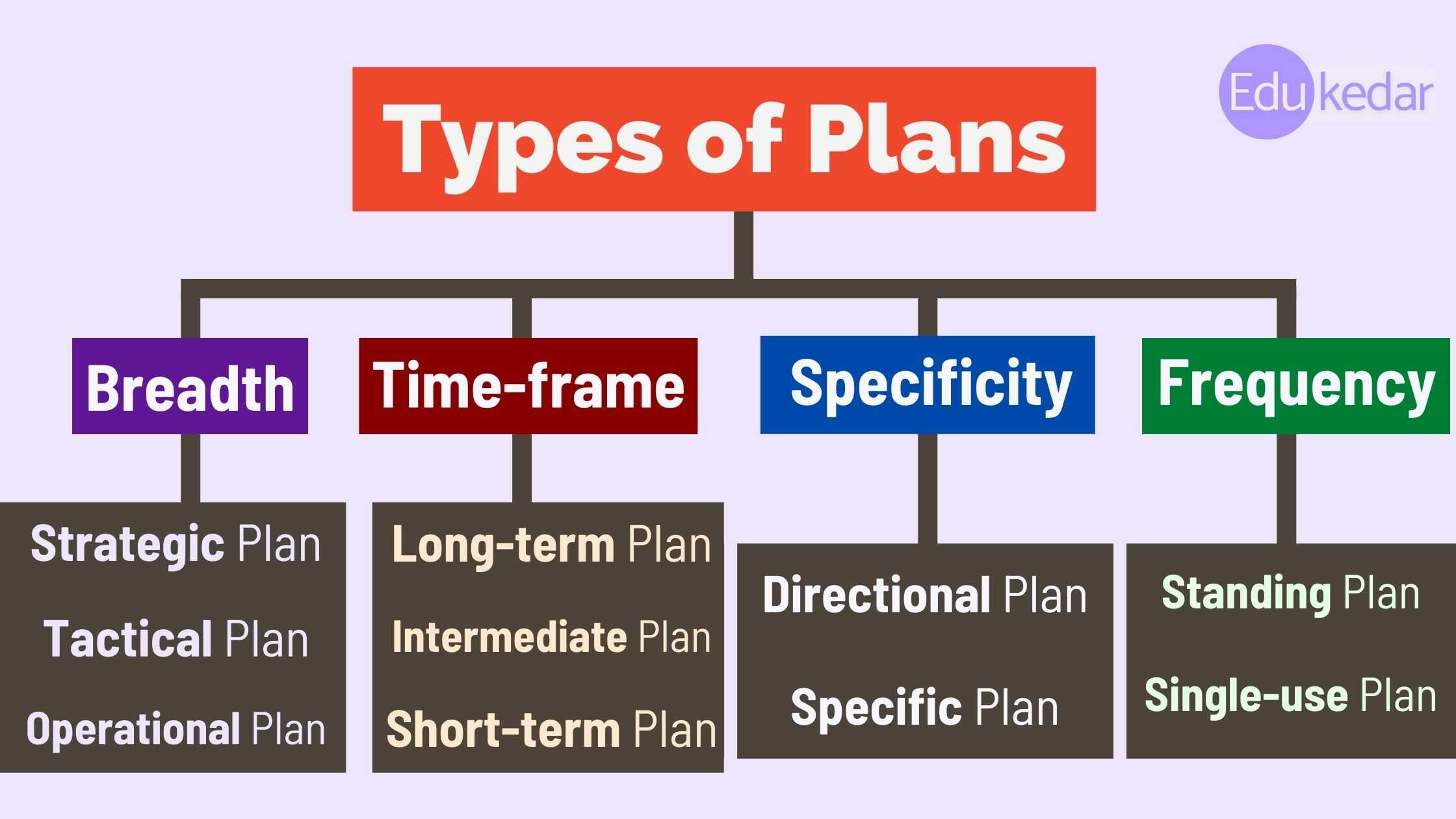Plans are essential to achieve any organizational goal and for the success of the business. Types of plans in business and management depend on the factors such as organizational activities, time-frame, specificity, and frequency of the plans. In this article, we have discussed all the different types of plans with examples.
► What is Plan in Management? (Definition)
A Plan is the outcome of the planning function and it is a written document that specifies the courses of action the organization will take.
- We have to do proper planning before creating any plan.
- Because Planning is the basic function by which we use to select our goals and objectives and make plans to achieve them.
- A large number of facts and information has to be gathered and processed before a plan is formulated.
To understand the concept of the plan, we have to know the basic difference between Planning and Plan.
Both words are similar but their meanings are different. There is a fundamental difference between planning and plan that can be understood by their literal meaning.
- Planning is an activity. It can be considered as consisting of a process, there are various sub-activities in the planning process. On the other hand,
- A Plan is a commitment to a particular course of action that is necessary to achieve specific results.
Also Read : Steps in Planning Process
► Types of Plans

The most popular way to describe types of plans is by their breadth. Business Plans can also be classified in terms of their time frame, specificity, and frequency.
The various types of plans are as following:
- Based on Breadth
- Based on Time-frame
- Based on Specificity
- Based on Frequency
There are many ways by which an organization can undergo the process of formulating a plan although the steps remain the same. But the thing that makes difference is where and how they will be implemented. So let’s discuss all these types of plans in detail.
◉ Types of Plans (based on Breadth)
- Strategic Plan
- Tactical Plan
- Operational Plan
✔ Strategic Plan:
Strategic Plans are formulated to provide direction for mission, objectives, and strategies for the organization. It defines the course of action by which a company intends to attain strategic goals.
Strategic plans are created by Top management such as the CEO, Board of Directors, Chairmen of the company. These plans become the framework and set dimensions for the lower-level planning in the organization.
For Example – Strategic Plans consist of the Vision, Mission, Values, and overall-Objectives of the Organisation. These are the key elements that clearly define the state of the business in terms of what to achieve in the future.
✔ Tactical Plan:
Tactical Plans are formulated to create the blueprint for the strategic plan. These plans clearly define how the strategic plan will be implemented.
Tactical plans are often short-term and are carried out by middle-level managers such as the Head of the Department, Sales Manager, HR Manager, Production Manager.
For Example – Managers of the company create plans to allocate required resources to support the strategic plan. HR Manager make plans to manage Human Resources of the company. Production managers make plans to smooth the production process of the business.
✔ Operational Plan:
Operational plans are very similar to Tactical Plan but they cover the day-to-day operations of the organization also. The specific results expected from departments, workgroups, and individuals are the operational goals.
An operational plan is one that a manager uses to accomplish his or her job responsibilities. Operational plans are also short-term in nature and created by Supervisors, team leaders, and facilitators to support tactical plans.
For Example – Team leaders have to manage daily shift timing schedules and allocate tasks to their subordinates, Supervisors make strategies to reach daily targets that should be completed according to the daily plan.
Also Read :10 Roles of Manager
◉ Types of Plans (based on Time-frame)
- Long-term Plan
- Intermediate-term Plan
- Short-term Plan
The time horizons are long term, intermediate-term, and short term.
✔ Long-term Plan:
Long-term planning includes strategic goals and plans and may extend as far as 3 to 5 years into the future. Top management is involved in the formulation of Long term plans.
For Example – Expansion of location, opening new branch offices, entering into a new market, investment in stock, bonds, and assets.
✔ Intermediate-term Plan:
Intermediate-term planning includes tactical objectives and has a time horizon of from 1 to 2 years. Middle-level managers are involved in the intermediate-term plan and they report to top management before the implementation of these plans.
For Example – Product Development, Plans to increase Market Share, Changes in annual Contracts,
✔ Short-term Plan:
Short-term planning includes operational objectives for specific departments and individuals. These plans are created by Supervisors and Team Leaders. And they have to report their manager of the department. Short term plan has a time period of 3 to 6 months or within a year.
For Example – Plans for increase Monthly Revenue, Hiring new employees for the company, Development programs for employees, Allocating monthly goals to employees.
Also Read : Types of Communication
◉ Types of Plan (based on Specificity)
- Directional Plan
- Specific Plan
✔ Directional Plan:
Directional plans are flexible plans that set out general guidelines. Such plans are preferable in a dynamic environment where management must be flexible in order to respond to unexpected changes.
For Example – the Sales Manager provides a guideline to his subordinates to the expected target and now how subordinates will achieve that it’s up to them. They are free to opt for any mode of practice. Hence we can say that the Directional plans are outcome focus.
✔ Specific Plan:
Those plans which are clearly defined objectives and leave no room for interpretation are called specific plans. Such plans require specific stated objectives and do not contain ambiguity.
For Example – the Production Manager briefing the plan to his subordinates as to what, when, where, how much, and by whom task will be performed. Hence we can say that the Specific Plans are Process Focused.
Also Read : Human Resource Planning
◉ Types of Plan (based on Frequency)
- Standing Plan
- Single-use Plan
✔ Standing Plan/On-going plan:
Standing plans are ongoing plans because they focus on organizational situations that occur repeatedly. Standing plans include policies, standard procedures, rules, and regulations of the organization.
For Example – Rules and policy of any organization are good examples of the standing plan because it provides a guideline for the course of actions taken in the company to achieve organizational goals. All members need to strictly follow these guidelines all the time.
✔ Single-use Plan:
Single‐use plans apply to activities that do not recur or repeat at the same time in the future. A one-time plan that is relevant for a specified time and after the lapse of that time, these plans are formulated again according to the situation for the next period.
For Example – Single-use plans typically include organizational programs, projects, budgets. A budget is also a single‐use plan because it predicts sources and amounts of income and how much they are used for a specific project.





